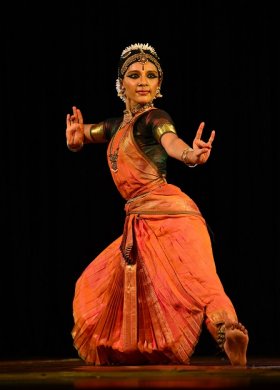
|   |

|   |
It's when "They Rose at Dawn" - Rashika Abrol e-mail: rashikalib@gmail.com November 4, 2015 Indian women are the keepers of rituals, are sensitive and are carriers of culture, values and relationships. Celebrating the versatile and liberating roles played by the women in India is what Aparna Ramaswamy’s latest solo production “They Rose at Dawn” does, presented recently at the Arts Centre, New York University, Abu Dhabi. It explores the everyday rituals performed by women in India, linking it to the greater role it plays in the lives of everyone connected to the household. A contemporary perspective though the practice is ancient.  Aparna Ramaswamy is a disciple of Alarmel Valli, living a life divided between India (Chennai) and the United States. She along with mother Ranee Ramaswamy and her sister Ashwini Ramaswamy runs the Ragamala Dance Company. Ragamala has been promoting Bharatanatyam through teaching, practicing and creating works that also reflect the process of cultural hybridity that Aparna has experienced and lived with in United States. ‘They Rose at Dawn’ was first presented at the Joyce Theatre, New York and then in NYU, Abu Dhabi. The one yet the many, the intimate yet the infinite is the `divine mother.’ The opening piece “Om Kara Karini,” a composition of Dr. Balamuralikrishna invocates this cosmic energy Devi, in ragam Lavangi set to talam adi. The choreography here is strong yet submissive where Aparna oscillates between the role of the divine and devotee exploring various facets of the feminine energy. Aparna’s journey as a woman continues in a Tanjavur Quartet varnam, a choreography of Alarmel Valli, where love and yearning become metaphors of the human spirit’s struggle and quest for liberation. After a musical interlude rendered by young violinist Anjna Swaminathan, Aparna moves from the internal dialogue of the protagonist to the realm of dialogue with the natural landscape. She uses two scenes from Mullai Tinai. The first scene is where a woman whose husband has gone to war is trying to make her baby sleep. In the other scene, her husband who is returning from war is in the forest where the deer and the stag are about to mate. Aparna’s choreography here is crisp yet deep and the end left the audience in a state of confusion where we don’t know if the deer and the stag mate or not. The choreography leaves scope for our own interpretations. The production ends with a piece called a “Swara Lahiri” in ragam Nalinakanthi set to adi talam. Nalinakanthi means a “beautiful woman” and the closing piece establishes the beauty of women, not the physical form but the spiritual form of women in India. It’s interesting to see how Aparna deeply rooted in tradition plays around with the technique and the idea to develop her own idiom of dance. The opening piece, the two scenes from Sangam Literature and the Swara Lahiri are her own choreographies where the musical arrangements and choice of ragam has all been chalked out by Aparna and her mother Ranee with the support of her orchestra members. The choreographic process as told by Aparna was of give and take between the dancer and the musicians and this dialogue is visible throughout the presentation. At some instances the music is inspired by the movement patterns and at some by the emotion and at many by both or vice-a-versa. The missing part from the performance was the critique of the thought that it tries to celebrate. Some practice the rituals and take pride in them, whereas some Indian women and men think that this role of culture bearers has burdened the women. Women as the epicenter of the celebrated ‘family unit’ itself is many times challenged and is two-sided. One felt that the voice of the “other” was missing and the performance needs a sequel to voice the ‘other’ side of the same thought. But maybe Aparna having been brought up in the US hasn’t been touched by this aspect prevalent more in the Indian subcontinent. Apart from Aparna’s sculpture like flawless rendition, the evening witnessed soulful music played by an excellent orchestra comprising of some eminent artistes from Chennai - Preethy Mahesh as the vocalist, C.K. Vasudevan on the nattuvangam, Sakthivel Muruganantham on mridangam and Anjna Swaminathan on violin. It’s also commendable how the New York University, Abu Dhabi staff transformed the entire look and feel of the black box. Some days back I saw an Opera in the same Black Box and then it was a different space where the artists were at the foothill of the audience. Now, it was a regular theatre for Bharatanatyam. Rashika Ojha Abrol is a Bharatanatyam exponent trained under the tutelage of Guru Saroja Vaidyanathan. She has her Bachelors in English Literature, Hindu College and Masters in Arts and Aesthetics, JNU. Rashika is interested in research on all kinds of arts especially performing arts. She is a freelance writer. |